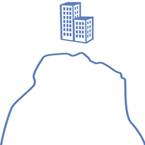Iceberg shapes, sizes and colours
Iceberg shape
| Shape | Average height to draft1 ratio |
| Tabular | 1:5 |
| Non-tabular |
1:5 |
| Domed |
1:4 |
| Pinnacle |
1:2 |
| Wedge |
1:5 |
| Drydock |
1:1 |
| Blocky |
1:5 |
Iceberg size
| Iceberg type | Iceberg Size | Height above sea surface (meters) | Length (meters) | Weight (Megatons) |
| Growler | |
less than 1 metre | less than 5 metres | 0.001 |
| Bergy Bit | |
1 metre to less than 5 metres | 5 metres to less than 15 metres | > 0.01 |
| Small Berg |  |
5 metres to 15 metres | 15 metres to 60 metres | >0.1 |
| Medium Berg |  |
16 metres to 45 metres | 61 metres to 120 metres | 2.0 |
| Large Berg |  |
46 metres to 75 metres | 121 metres to 200 metres | 10.0 |
| Very Large Berg |  |
Greater than 75 metres | Greater than 200 metres | Greater than 10.0 metres |
Iceberg colour
Icebergs are mostly white because the ice is full of tiny air bubbles. The bubble surfaces reflect white light giving the iceberg an overall white appearance. Often, white icebergs will have bluish streaks running through them. This blue tinted ice has no air bubbles to reflect white light and gets its blue colour from the same light phenomenon that tints the sky.
White ice is created inside of a glacier. As snow falls over thousands of years, it piles up and compacts the snow under it. During this compaction process, any air bubbles between the snowflakes are trapped. Finally, after the snow and air bubbles have been compacted over many years, they become the white ice that icebergs come from.
Blue, bubble free ice is made when the ice is still part of the glacier. Melt water fills crevasses formed in the glacier as it creeps over land and quickly freezes without any air bubbles forming.
Occasionally airborne dust or dirt eroded from land ends up on the glacier surface eventually forming a noticeably darkened brown or black layer within the ice of a floating iceberg. This brown or black layer has nothing to do with bubbles. The ice is just dirty!
